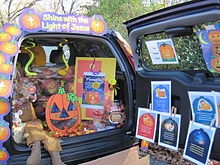
Halloween or Hallowe'en is a celebration observed in many countries on 31 October, the eve of the Western Christian feast of All Hallows' Day. It is at the beginning of the observance of Allhallowtide, the time in the liturgical year dedicated to remembering the dead, including saints (hallows), martyrs, and all the faithful departed. In popular culture, the day has become a celebration of horror, being associated with the macabre and supernatural.

Trick-or-treating is a traditional Halloween custom for children and adults in some countries. During the evening of Halloween, on October 31, people in costumes travel from house to house, asking for treats with the phrase "trick or treat". The "treat" is some form of confectionery, usually candy/sweets, although in some cultures money is given instead. The "trick" refers to a threat, usually idle, to perform mischief on the resident(s) or their property if no treat is given. Some people signal that they are willing to hand out treats by putting up Halloween decorations outside their doors; houses may also leave their porch lights on as a universal indicator that they have candy; some simply leave treats available on their porches for the children to take freely, on the honor system.
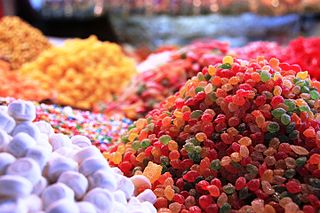
Candy, alternatively called sweets or lollies, is a confection that features sugar as a principal ingredient. The category, also called sugar confectionery, encompasses any sweet confection, including chocolate, chewing gum, and sugar candy. Vegetables, fruit, or nuts which have been glazed and coated with sugar are said to be candied.
The Chicago Tylenol murders were a series of poisoning deaths resulting from drug tampering in the Chicago metropolitan area in 1982. The victims consumed Tylenol-branded acetaminophen capsules that had been laced with potassium cyanide. Seven people died in the original poisonings, and there were several more deaths in subsequent copycat crimes.
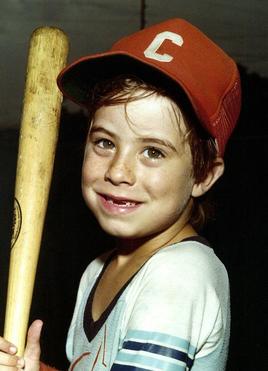
Adam John Walsh was an American child who was abducted from a Sears department store at the Hollywood Mall in Hollywood, Florida, on July 27, 1981. His severed head was found two weeks later in a drainage canal alongside Highway 60 / Yeehaw Junction in rural Indian River County, Florida. His death garnered national interest and was made into the 1983 television film Adam, seen by 38 million people in its original airing.

Golden Crisp, also known as Sugar Crisp in Canada, is a brand of breakfast cereal made by Post Consumer Brands that consists of sweetened, candy-coated puffed wheat and is noted for its high sugar content. It was introduced in the United States in 1948.
A rainbow party is a supposed group sex event featured in an urban legend spread since the early 2000s. A variant of other sex party urban myths, the stories claim that at these events, allegedly increasingly popular among adolescents, girls wearing various shades of lipstick take turns fellating boys in sequence, leaving multiple colors on their penises.

Fruit Roll-Ups is a brand of snack that debuted in grocery stores across America in 1983. It is a flat, corn syrup-based, fruit-flavored snack rolled into a tube, spread on a backing sheet of cellophane to prevent the product from sticking to itself.

Ronald Clark O'Bryan, nicknamed The Candy Man and The Man Who Killed Halloween, was an American man convicted of killing his eight-year-old son Timothy on Halloween 1974 with a potassium cyanide-laced Pixy Stix that was ostensibly collected during a trick or treat outing. O'Bryan poisoned his son in order to claim life insurance money to ease his own financial troubles, as he was $100,000 in debt. O'Bryan also distributed poisoned candy to his daughter and three other children in an attempt to cover up his crime; however, neither his daughter nor the other children ate the poisoned candy. He was convicted of capital murder in June 1975 and sentenced to death. He was executed by lethal injection in March 1984.
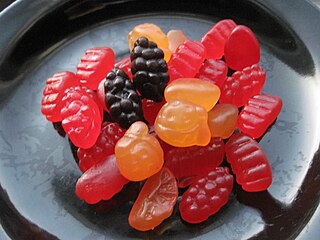
A fruit snack is a type of gummy snack made with fruit flavoring and natural gelatin. They were first made by confectioner Louis Shalhoub in the 1970s as a lightweight high energy snack food for backpackers. Although they are marketed as a healthier alternative to regular gummy candies, this is sometimes considered false advertising, since they contain fruit flavoring instead of actual fruit and the high added sugar content, more comparable to a typical candy.
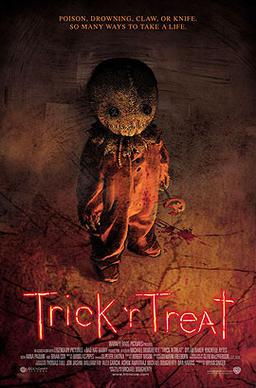
Trick 'r Treat is a 2007 American anthology horror film written and directed by Michael Dougherty and produced by Bryan Singer. The film stars Dylan Baker, Rochelle Aytes, Anna Paquin and Brian Cox. It relates four Halloween horror stories with a common element in them: Sam, a trick-or-treating demon wearing orange footie pajamas with a burlap sack over his head. The character makes an appearance in each of the stories whenever one of the other characters breaks a Halloween tradition.
Many urban legends and misconceptions about drugs have been created and circulated among young people and the general public, with varying degrees of veracity. These are commonly repeated by organizations which oppose all classified drug use, often causing the true effects and dangers of drugs to be misunderstood and less scrutinized. The most common subjects of such false beliefs are LSD, cannabis, and MDMA. These misconceptions include misinformation about adulterants or other black market issues, as well as alleged effects of the pure substances.

Trick-or-Treat for UNICEF is a fund-raising program for children sponsored by the U.S. Fund for UNICEF. Started on Halloween 1950 as a local event in Philadelphia, Pennsylvania, United States, the program historically involves the distribution of small orange boxes by schools to trick-or-treaters, in which they can solicit small change donations from the houses they visit. Millions of children in the United States, Canada, Ireland, Mexico, and Hong Kong participate in Halloween-related fund-raising events for Trick-or-Treat for UNICEF, and the program has raised over US$188 million worldwide.
An availability cascade is a self-reinforcing cycle that explains the development of certain kinds of collective beliefs. A novel idea or insight, usually one that seems to explain a complex process in a simple or straightforward manner, gains rapid currency in the popular discourse by its very simplicity and by its apparent insightfulness. Its rising popularity triggers a chain reaction within the social network: individuals adopt the new insight because other people within the network have adopted it, and on its face it seems plausible. The reason for this increased use and popularity of the new idea involves both the availability of the previously obscure term or idea, and the need of individuals using the term or idea to appear to be current with the stated beliefs and ideas of others, regardless of whether they in fact fully believe in the idea that they are expressing. Their need for social acceptance, and the apparent sophistication of the new insight, overwhelm their critical thinking.

Halloween is a celebration observed on October 31, the day before the feast of All Hallows, also known as Hallowmas or All Saint's Day. The celebrations and observances of this day occur primarily in regions of the Western world, albeit with some traditions varying significantly between geographical areas.
"Halloween Surprise" is the fifth episode of the fifth season of the American comedy television series Parks and Recreation, and the 73rd overall episode of the series. It originally aired on NBC in the United States on October 25, 2012.

Tales of Halloween is a 2015 American comedy horror anthology film consisting of ten interlocking segments, each revolving around the holiday indicated by the title. Segments were directed by Neil Marshall, Darren Lynn Bousman, Axelle Carolyn, Lucky McKee, Andrew Kasch, Paul Solet, John Skipp, Adam Gierasch, Jace Anderson, Mike Mendez, Ryan Schifrin, Dave Parker and, in his film debut, Jack Dylan Grazer.

Lisa Ann French was a 9-year-old girl from Fond du Lac, Wisconsin, who was sexually assaulted and murdered by her neighbor, Gerald Miles Turner Jr., on Halloween night 1973, while she was trick-or-treating alone.

